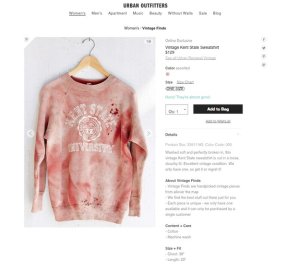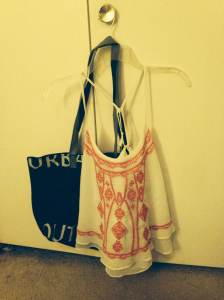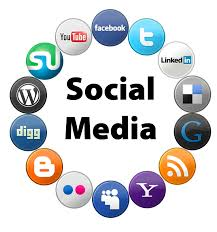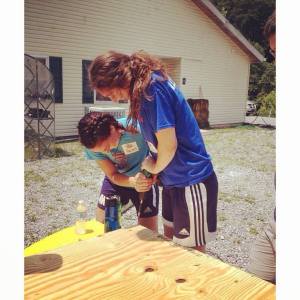As stated by Dr. Luttrell, from Social Media, “We can no longer argue that social media is on the rise or that it is in the early phases of adoption. Social media is here, and it is growing leaps and bounds.” That statement proved to be true after social media blew up today on multiple sites, such as Facebook, Twitter, and Instagram when Urban Outfitters launched a vintage Kent State University sweatshirt that had blood splatter on it. This $129 sweatshirt was emulating an infamous school shooting that happened in 1970, when four students were shot by National Guard after protesting the Vietnam War. Both Urban Outfitters and Kent State had something to say after the picture of the sweatshirt went viral. Now where to begin with this clothing disaster, I guess the idea behind the sweatshirt.

Vintage Kent State sweatshirt from Urban Outfitters website.
http://www.businessinsider.com%2Furban-outfitters-kent-state-sweatshirt-bloodstain-
Urban Outfitters has come out with a statement apologizing saying, ” It was never our intention to allude to the tragic events that took place at Kent State in 1970 and we are extremely saddened that this item was perceived as such. This one of-a-kind item was purchased as part of our sun-faded vintage collection. There is no blood on this shirt nor has this item been altered in any way. The red stains are discoloration from the original shade of the shirt and the whole are from natural wear and fray.” -Urban Outfitters spokesperson.
I guess I see two sides of this argument for Urban Outfitters and the public. First, for anyone who has either shopped in Urban Outfitters or seen their clothing in various outlets know that they have very outside the box clothing. I personally like there clothes and have many pieces from their collections. Although, this certain sweatshirt could be exactly what the company said about it, ” the red stains are discoloration from the original shade.” This certain garment really could just have that certain pattern on it, not meaning to portray a horrific event in American history. Having worked in the retail industry for nine years, I understand that the manufacturing can vary the results of how a clothing items looks. This brings me to my next point, why would Urban Outfitters allow for a garment to be on their shelves that gave customers the idea that emulated a gunshot wound to the arm, with blood splatter. This was a massive event that effected thousand that were involved in the protest, and those around the country. If a retailer wants to selling a college sweatshirt, its probably not in their best interest to sell it with blood stains and bullet holes on it, with a school logo that had a massive shooting.
Now, I am very conflicted on what to think about this sweatshirt. I shop frequently at Urban Outfitters, so much that I actually have a shopper tote. So does this make me a certain type of hypocrite for having so much of their products, but bad mouthing the company at times when no one wants to be associated with them? I feel that I am stuck in the middle of this trending social issue, but after reading the facts, I think that I am more disappointed in Urban Outfitters than anything else. Again, this is my personal opinion and I’m curious to know what your thoughts are on the matter?
This has not been the company’s first controversial clothing item, as it has battled criticism time and time again. Some of these items include from the week.com, pro-booze for kids, the Holocaust-evoking “Jewish Star” shirt,” Obama/Black” T-shirt, and the “Eat Less” T-shirt. I have a feeling that this will not be the last time Urban Outfitters will be in the news for outrageous and offensive clothing.
Due to the masses that flock to social media, it allowed for this story to be spread quickly to those over a multitude of sites. As an effect of social media being so profoundly used daily, this sweatshirt spread like wild fire. As chapter two stated media allows us to make channels through which we make connections with others in many forums. We can now connect through pictures, websites, and mobile devices. If we didn’t have this great social media source, I don’t think that this news of this sweatshirt would have spread as fast. Today, I saw this link being posted to numerous social media forums. This caused a chain reaction of outcries from a magnitude of people. Another piece that stood out to me from chapter two was, from Barlow saying, ” Internet has created a generation of people accustomed to finding their own answers, creating their own systems, forming their own new communities.” By Urban Outfitters creating this sweatshirt, it left an open-ended meaning for consumers. As a result of their actions, the internet allowed for the sweatshirt to be shared on social media sites and communities of people began to assume that they wanted to recreated something from the Kent State shooting.
From the Circular Model of SoMe for Social Communication, the four components: share, optimize, manage, engage were majorly used by Urban Outfitters today, and by PR practitioners to fix this mixed message for the company. The company shared by rebuilding trust and connection with outside sources such as their customers, news outlets, and Kent State. Urban had to optimizes by reading and listing to authentic conversations that were happening about how customers felt about the sweatshirt. PR practitioners had to manage the media by quickly jumping on responses due to major criticism of the company’s bad choice in clothing making. Finally, PR practitioners and the company had to engage on how they would reach the audiences effectively.



